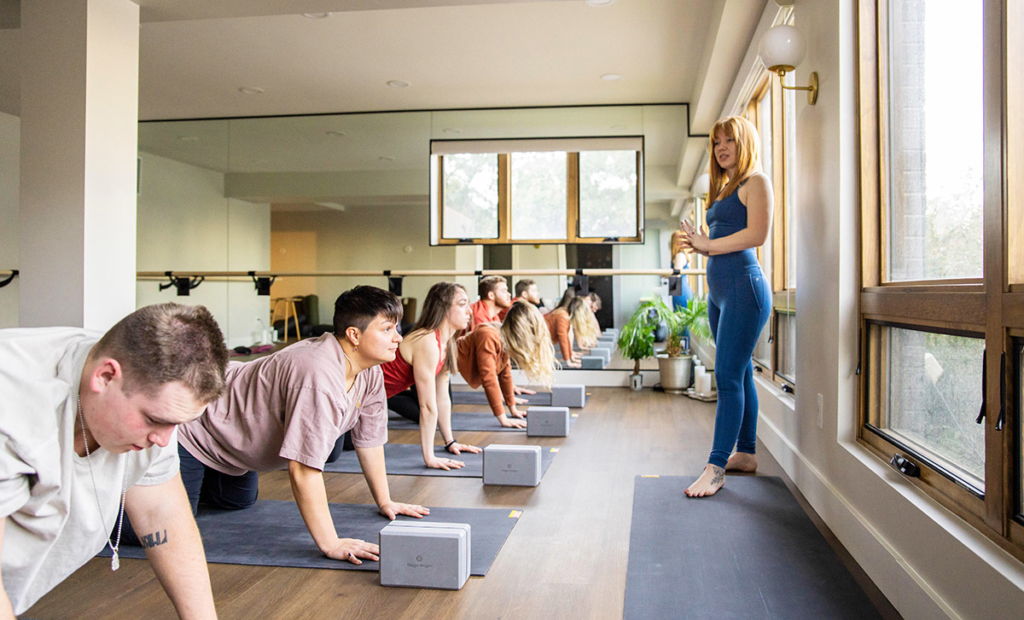
Do you ever get tired of hearing your yoga teaching “script?” I do. I’ve been teaching yoga since 1986, and sometimes it hits me that I seem to say the same things over and over—and over and over.
This is partly okay. I’ve spent considerable energy crafting my teaching language. As a writer, I like to be concise, using as few words as possible to get my point across. I also like to be precise, using just the right combination of words to convey what I’m trying to communicate. As a teacher, I’m aware of the power of language to inspire or to convey judgment or to project my perspective onto my students. It’s a delicate balance that I continue to hone.
I also sometimes find that I tend to get stuck in a rut in the way I sequence asanas. For example, I’ve found that sequencing standing poses in a certain order makes structural sense. Each pose prepares the body for the next one. But is that the only way to sequence standing poses? Of course not. I recently completely upended my standing sequence in a couple classes. The results were energizing and revitalizing.
Stick with What Works, or Change it Up?
I often wonder if my students tire of hearing the same language. (Most of them have been attending my classes for 10 to 20 years or more.) I imagine they sometimes do. But I also know that hearing something repeatedly can eventually lead to hearing it differently one day. Students have told me as much: “I’ve heard you say such-and-such many times, but I just finally got it today.”
But as a longtime Deadhead back in the day, I always feel compelled to change it up sometimes. (The Grateful Dead never played the same show twice, and didn’t play their songs the same way each time.) I like to challenge myself by tuning into my students’ needs and letting the sequence flow in surprising ways. I sometimes enjoy not knowing what the next pose will be until a split second before we practice it. On the other hand, lots of people like a set routine, a practice they can count on. So which way is best?
As always, there’s not one yoga teaching technique that will satisfy everyone. A combination of giving students something familiar to hang onto, while also introducing new ways of practicing seems to strike the right balance for me.
How to Enliven Your Yoga Teaching
Here are two suggestions for changing up your yoga teaching:
- Practice: Keeping your home practice vital is probably the most important thing I can encourage you to do. Your home practice is where you can experiment with changing your sequencing. This is how you can find out what works and what doesn’t, for your own body. Then you can take what you’ve learned into your yoga teaching. Be aware, of course, that if you’re a bendy or athletic practitioner, that your students may not be able to do the “fancier” poses. Use your home practice to come up with ways to modify poses, using Yoga Blocks, Yoga Straps, Yoga Blankets or Yoga Bolsters. That way, you can offer your students alternatives that give them the same benefits as the pose you’re practicing.
- Play with language: As a writer, I’ve trained myself to look for different ways to say things. I like to use words that are precise and descriptive. I edit lots of yoga writing in my profession, and I consistently read instructions that use all-purpose generic words. “Bring” is one of the most common ones. As a very simple example, instead of “bring your feet to hips-width apart” I‘ will say “step your feet to hips-width apart.” I know this seems very picky and trivial, and generic words are not wrong. Students generally get what you’re trying to say. But playing with using different words and changing your phrasing can sometimes lead to new understanding, both for yourself and for your students.
- Keep learning: Take classes from other teachers. Listen to how they communicate and learn new ways of approaching practice. If you live in an area where you don’t have access to teachers, look online. YogaUOnline, in particular, offers high-quality online workshops and courses.
Yoga Teaching is an Inward Journey
Ultimately, effective teaching entails a balance between going with what you know and learning new ways of communicating. You don’t have to give up the techniques that you know benefit your students. But in order for your yoga teaching practice to continue to grow, you must challenge yourself. This doesn’t mean you have to continue to practice and teach ever more “advanced” poses. It points, instead, to experimenting with the tools you’ve already cultivated. It means looking inward to discover the more subtle effects of sequencing. It’s an opportunity to play with language, and to consider the effects of the words you use.
As Suzuki Roshi famously wrote in Zen Mind, Beginners Mind, “In the beginners mind there are many possibilities. In the expert’s mind there are few.” Keep your mind open to new ways of practicing and teaching.
